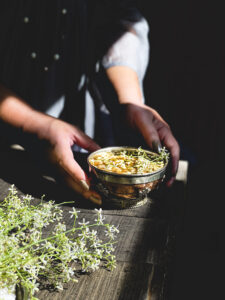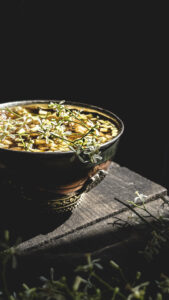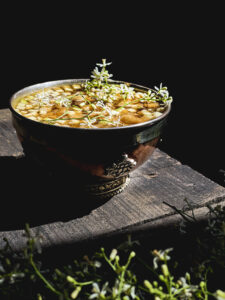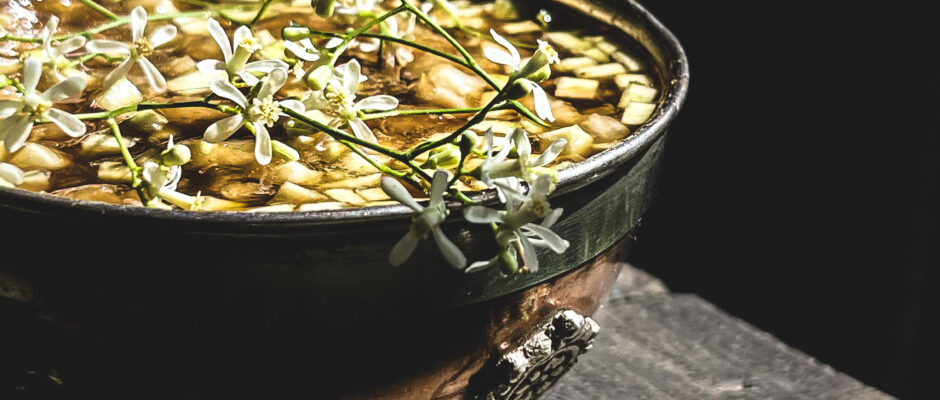It’s been awhile since I shared my thoughts here. I have been fortunate enough to write for brands and websites whose thought processes match my own so it’s just that I haven’t managed to make time to connect with you all here. I hope to change that and also hope to get some conversation going as well.

Ugadi pachadi at home
The journey since starting this blog has been extremely gratifying ,not just in the way I get to do what I love, but also in meeting some amazing people. We hear stories of people who are passionate about what they do and how they will stop at nothing to achieve their dream …let me tell you, it is 100% true ! It is the pure intention behind the work that propels them forward .

Ugadi pachadi
This Ugadi pachadi is something that was fed to me all through my growing up years. My mother would urge me to swallow it quickly so that the bitter taste of the neem flowers was never felt and all that remained was the sweet taste from the jaggery and banana.The significance being, that life is filled with all sorts of encounters and moments; bitter, sour, spicy, salty and sweet. We need to find a way to swallow the rest and only allow the sweet to linger on. It’s not a fairytale…there are so many motivational speakers and spiritual gurus who talk about focussing on spiritual growth and surrounding ourselves with people and instances which add joy.
Our ancestors were wise beyond their time !!!
When I began to follow this tradition in my home ,I had no idea what all went into making the Ugadi pachadi.. All I remembered was seeing the blobs of banana and the pretty neem flowers. so for many years it was just that. ( I don’t know why I didn’t think to ask my mother) Maybe I assumed that it was something I should know and she would be disapproving of me if I had asked…the assumptions which complicate our lives are many 😉
When I was given the opportunity to explore the seasonal and regional foods of Coimbatore thanks to my weekly food column in The Hindu, I discovered a fascinating world .This world was familiar to me since I was a part of growing up amidst all these practices and rituals but what I did not know was how important it was and is for our mental and physical well-being.

Thus started my journey of documenting this precious knowledge in English- a language that my generation and the ones thereafter are most comfortable reading in. I love my native languages and can speak Tamil and Telugu fluently with an above average comfort in speaking Hindi. Out of these the only one that I can read & write well in is Tamil.
When I started writing about our local foods (some of which are fast disappearing ) I did not expect to get so much love and support from the people here. aunts, grand aunts, elders from the community would tell my mother that they enjoyed reading my articles. When my column stopped they thought I had lost interest in writing. When I told them that I still write, I am rewarded with beaming smiles and generous pats on my back.
so I write this so that we understand that our traditions are closely connected to the seasons and our love for what the land offers. Ugadi ,according to the Sanskrit calendar, is the New Year for the Telugu and also the Kannadiga community. We start the day by offering prayers to the Lord along with the Ugadi pachadi. It contains jaggery mixed with water, bits of green mango, young neem flowers, mashed banana and the extract from young tamarind. This year I also added black pepper because I read that there needs to be a spice element in the pachadi and black pepper is a native food which existed long before chillies were introduced. I also found out that the banana and tamarind extract addition are optional and vary from one family pachadi recipe to the next.
Another reason I write this post is the health benefits of having these unique ingredients. We don’t have too many ingredients which give a bitter taste. But bitter is important for aiding digestion, purifying blood and keeping the immune system healthy. So the delicate neem flowers (don’t judge a book by it’s cover ) are intensely bitter and help in cleansing our bodies with its anti fungal and anti bacterial properties. They stay in season for 4-6 weeks so it starts with the Ugadi pachadi and then follow the neem rasam (vepampoo rasam sounds better), vepampoo vadagam etc. It’s also a common practice to dry the neem flowers and sauté them in ghee before storing in an airtight container. Don’t give the ghee a miss (we are all so clued in to calories aren’t we ) Without the ghee, the properties of the dried neem flowers will not get assimilated into the body.
Isn’t it incredible that we embrace seasonal availability and turn it into a ritual which spreads good vibes ? I think it’s pure genius !
This is what keeps children connected to their roots … a large dose of traditional love offered with enough information on the side ,kept ready to answer the (famous ) But whyyyy 😀
Love and light to all .


No comments yet.